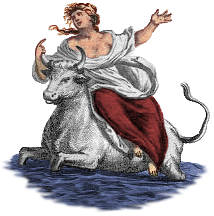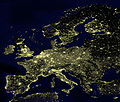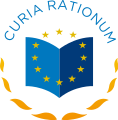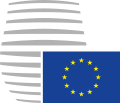
Back بوابة:الاتحاد الأوروبي Arabic Portal:Avropa İttifaqı Azerbaijani প্রবেশদ্বার:ইউরোপীয় ইউনিয়ন Bengali/Bangla Portal:Unió Europea Catalan Portál:Evropská unie Czech Portal:Den Europæiske Union Danish Portal:Europäische Union German Πύλη:Ευρωπαϊκή Ένωση Greek Portal:Unión Europea Spanish Teemasivu:Euroopan unioni Finnish
Introduction
The European Union (EU) is a supranational political and economic union of 27 member states that are located primarily in Europe. The Union has a total area of 4,233,255 km2 (1,634,469 sq mi) and an estimated total population of over 448 million. The EU has often been described as a sui generis political entity (without precedent or comparison) combining the characteristics of both a federation and a confederation. Containing 5.8% of the world population in 2020, EU member states generated a nominal gross domestic product (GDP) of around US$16.6 trillion in 2022, constituting approximately one sixth of global nominal GDP. Additionally, all EU states except Bulgaria have a very high Human Development Index according to the United Nations Development Programme. Its cornerstone, the Customs Union, paved the way to establishing an internal single market based on standardised legal framework and legislation that applies in all member states in those matters, and only those matters, where the states have agreed to act as one. EU policies aim to ensure the free movement of people, goods, services and capital within the internal market; enact legislation in justice and home affairs; and maintain common policies on trade, agriculture, fisheries and regional development. Passport controls have been abolished for travel within the Schengen Area. The eurozone is a group composed of the 20 EU member states that have fully implemented the economic and monetary union and use the euro currency. Through the Common Foreign and Security Policy, the union has developed a role in external relations and defence. It maintains permanent diplomatic missions throughout the world and represents itself at the United Nations, the World Trade Organization, the G7 and the G20. Due to its global influence, the European Union has been described by some scholars as an emerging superpower. In 2012, the EU was awarded the Nobel Peace Prize. The United Kingdom became the only member state to leave the EU, in 2020; ten countries are aspiring or negotiating to join it. (Full article...) Selected articleThe European Commission forms part of the executive branch of the European Union. It is one of the Union's three main political Institutions. It is a cabinet government of 27 Commissioners led by a Commission President. The current President is Ursula von der Leyen, who leads the von der Leyen Commission and assumed office in 2019. It is responsible for proposing legislation, implementing decisions, upholding the Union's treaties and the general day-to-day running of the Union. The Commission is based in the Berlaymont building in Brussels and is supported by an administrative body of about 23,000 European civil servants divided into departments called Directorate-General. The term "Commission" can either mean the entire administrative body of the Commission or just the college of 27 Commissioners. Its internal working languages are English, French and German. Selected picturePainting: František Kupka The Cathedral is an abstract oil painting on canvas created by Czech artist František Kupka in 1912–1913. Measuring 180 by 150 centimetres (71 in × 59 in), the painting is held by the Museum Kampa in Prague, Czech Republic. In this painting, vertical lines running the entire length of the canvas are intersected by diagonal lines to form rectilinear shapes of various sizes and colors.
Did you know?...that France possesses the largest exclusive economic zone (EEZ) in the world? ...that Monaco, San Marino, and Vatican City all mint their own euro coins, with their own national symbols on the back? ...that Turkey's two most famous weightlifters, Naim Suleymanoglu and Halil Mutlu are only two of four weightlifters in the world to have won 3 gold medals in 3 olympics? Selected cityTallinn is the capital city and main seaport of Estonia. It is situated on the southern coast of the Gulf of Finland, in north central Estonia., 80 kilometres south of Helsinki. Tallinn's population is registered at 399,180 (as of November 2006). In 1154 Tallinn was marked on the world map of the Arab cartographer al-Idrisi. As an important port for trade between Russia and Scandinavia, it became a target for the expansion of the Teutonic Knights and Kingdom of Denmark during the period of Northern Crusades in the beginning of the 13th century when Christianity was forcibly imposed on the local population. Danish rule of Tallinn and Northern Estonia started in 1219. According to Eurostat, the statistical agency of the European Union, of all EU member states' capital cities, Tallinn has the largest number of non-EU nationals: 27.8% of its population are not EU citizens. General imagesThe following are images from various European Union-related articles on Wikipedia.
TopicsFeatured contentFeatured articles
Featured lists
Featured contentGood articles
CategoriesRelated portalsAssociated WikimediaThe following Wikimedia Foundation sister projects provide more on this subject:
Discover Wikipedia using portals |
© MMXXIII Rich X Search. We shall prevail. All rights reserved. Rich X Search































































